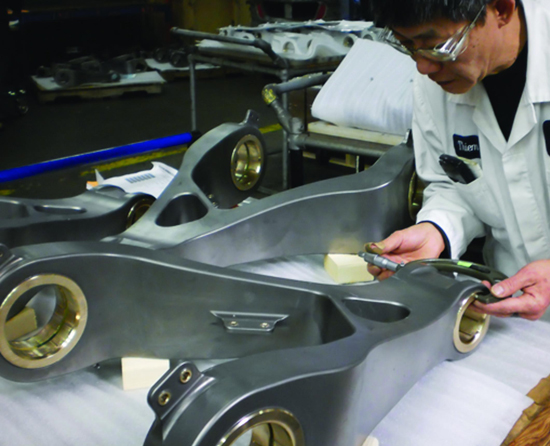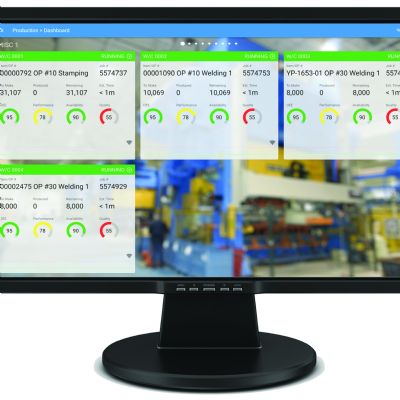Worldclass OEE Lands at Supplier of Jet-Fighter Parts
June 1, 2014Comments
Machine-to-machine monitoring catalyzes efforts to raise overall equipment effectiveness to world-class levels at Magellan Aerospace, saving the company more than $30,000/month in downtime-related costs.
With more than 60 yr. of producing components for some of the most sophisticated supersonic jet-fighter aircraft in the world, longevity for the Magellan Aerospace plant in Kitchener, Ontario, Canada, is partly due to its expertise in high-velocity hard-metal machining of titanium, Inconel and stainless steel. The firm manufactures major components for the futuristic F-35 Lightning II fighter, as well as landing gear and other key components for most major aerospace-OEM platforms.

Magellan’s continuous-improvement coordinator Jonathan Ung checks data gathered by the Merlin machine-to-machine communications platform.
The 135-employee, 100,000-sq.-ft. plant boasts of relentless pursuit of excellence, which recently led it to invest in new “shop floor to top floor” software supplied by Memex Automation, Burlington, Ontario, Canada. Its Merlin (Manufacturing Execution Real-time Lean Information Network) software is a manufacturing execution system and machine-to-machine communications platform that provides real-time visible dashboard metrics.
Merlin executes work orders generated by an ERP system and sends the results back to the central ERP database. Other functions include production data collection, downtime and reject-cause analysis, labor-productivity tracking, usage-based preventive maintenance and visual production scheduling. Users, such as Magellan, leverage information captured by Merlin to increase production and income from operations, while raising overall equipment effectiveness (OEE).
Reduced Optional Machine Stops
Dave Quehl, Magellan Aerospace’s manager of technical services, oversaw installation of the Merlin software in 2011, and has it running on various machines throughout the plant. Continuous-improvement coordinator Jonathan Ung is charged with tracking the plant’s progress with Merlin; he has gathered very promising return-on-investment results.
“We deployed Merlin on our FMS/Makino cell,” says Ung, “which features four robot-controlled CNC machines. We also outfitted three stand-alone CNC machines configured in a cell-like environment. The stand-alone machines utilize the Merlin Ax9150 hardware board along with the G55 handheld scanner, giving us visibility of the machines that we previously lacked. The Merlin operating portal on the Makino cell provides detailed machine information right on the shop floor. We feed Merlin with work-order and product standard data directly from our Cincom ERP system.”
 |
| Quality-control inspection of finished products at Magellan is complemented by Merlin’s ability to track more than 100 key-performance indicators on machine tools, including product rejects. |
Ung notes that prior to installing Merlin, the stand-alone machines were not reaching production targets and the plant was considering buying another machine. “Merlin identified and then helped us reduce optional machine stops, or M01 codes,” he says, “programmed in by an operator. The data showed us that there were far too many M01s and other downtime events. We shared this information with our team, which was able to reduce the number of monthly hours caused by downtime events from 400 hr. down to 100 hr. This resulted in a net increase in machining capacity of 100 hr./month per machine. Multiply that by the hourly machining cost and we captured real savings of more than $30,000/month against an initial price for Merlin of $20,000. That’s a very satisfying payback on the technology.”
On one of its machines, says Ung, the shop was able to more than double machining time, for a 100-percent-plus efficiency gain. “It was so much of a gain that it was surreal at first,” says Ung, “with experienced operators very surprised to see the results.
“Previous to Merlin,” continues Ung, “shopfloor supervisors would manually record information regarding start and end times, and quantity produced during the shift. However, the information didn’t provide the detail that enables better decision-making. With Merlin in place, we’ve seen a dramatic drop in time spent gathering data, along with a notable increase in the amount of data available to management and to operators.
“It’s important to be able to put the information in front of the operators so they can see the change in performance as changes are made in operating procedures,” continues Ung. “Merlin provides a truthful record of problems and, as the Pareto principle shows, we can quickly focus on the 20 percent of issues that result in 80 percent of our problems.”
Data Fuels a Lean PDCA Methodology
After collecting a month’s worth of information from Merlin, Ung and his team initiated a lean plan-do-check-act (PDCA) methodology with corrective actions.
“Memex supplied this in its ‘Roadmap to Success’ methodology,” says Ung, “a valuable tool for analyzing and interpreting the information Merlin makes available.”
After completing the corrective actions, Ung was able to show that Merlin brought the plant’s OEE to a sustained 85-percent-plus, up from 36 percent.
Day-to-day, Merlin provides Ung and his team with instantaneous as well as timed e-mail alerts to minimize downtime. Dashboards, displayed on video screens throughout the shop floor, communicate realtime machine status.
More Benefits Coming
“We still do not use Merlin to collect quality information, as we are determining how to effectively apply that information in our shop,” says Ung. “We know we are just scratching the surface of what Merlin can do.”Ung also notes his desire to tie Merlin into the firm’s ERP system to track shop orders and labor hours. And he wants to add MTConnect, “which will make it even easier for Merlin software to gather and read data in all formats from all of our machines,” Ung says. “We see a lot more savings in the future.” MF
View Glossary of Metalforming Terms
See also: Memex Automation
Technologies: Management, Software









